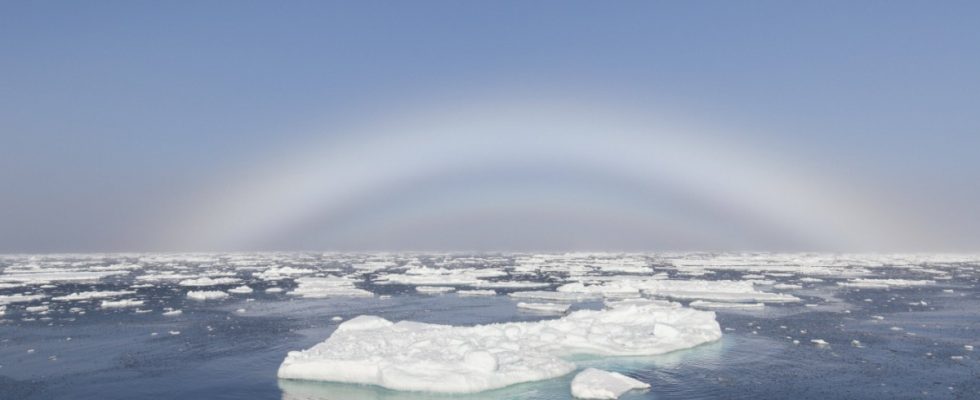Almost a decade ago, mysterious craters began to appear in the deserted tundra of the Yamal Peninsula in northern Siberia. As it turned out later, methane gas had blasted these up to 60 meter deep holes in the landscape. During thawing processes, the gas accumulated at weak points in the frozen subsoil and finally erupted.
However, large amounts of greenhouse gases are not only slumbering in the permafrost on land, but also in the icy seabed off the coasts around the Arctic Ocean. The gases are bound there in so-called submarine permafrost, i.e. in the frozen sea floor. With the help of echo sounder and sonar measurements, scientists repeatedly discovered groups of large and small craters at various points there, from which veils of methane gas bubbles bubble to the sea surface. Some scientists therefore see the submarine permafrost as a ticking time bomb. Sudden eruptions, they fear, could catastrophically fuel global warming.
Little is known about the seabed, which is interspersed with ice. Even its distribution has not yet been mapped with certainty everywhere. All that is known is that of the total of 2.5 million square kilometers of submarine permafrost, about 80 percent lies under the shallow sea on the continental shelf off north and east Siberia, and 20 percent off the coasts of Alaska and Canada.
It is estimated that between three and 17 million tons of methane are currently emitted there each year. For comparison: Man-made methane emissions were around 272 million tons worldwide in 2017. “According to more recent knowledge, the gases have only been escaping slowly,” says Paul Overduin, a permafrost specialist at the Alfred Wegener Institute for Polar and Marine Research (AWI) in Potsdam. So Overduin describes it together with colleagues in a recently published study. The question, however, is whether this leisurely pace will remain.
Submarine permafrost, like land permafrost, formed during the last Ice Age. At that time, a lot of water was bound in the glaciers on the poles. The sea level was therefore 120 meters lower than today. An ice-cold tundra spread out on land – a mammoth steppe with temperatures of minus 15 degrees Celsius on an annual average. So the ground is frozen through with all the remains of dead plants and animals, in places more than a kilometer deep.
At the end of the Ice Age, when sea levels rose again by 120 meters, seawater flooded this cold steppe for many kilometers along the Arctic coast, and even hundreds of kilometers inland in Siberia. Since then, a large piece of permafrost has been under the sea.
There is so much energy in methane hydrate that you can light this ice cream
For Paul Overduin, the submarine permafrost has two functions in the global climate system: On the one hand, it acts as a freezer in which deep-frozen organic material is safely stored as long as the temperatures on the sea floor are below freezing. Unlike permafrost on land, the remains cannot be decomposed by microorganisms at higher temperatures in summer, releasing greenhouse gases such as methane and carbon dioxide.
On the other hand, the undersea permafrost works like a cover that spans a substrate that is sometimes even more problematic for the climate: methane hydrates. This mixture of frozen water and methane gas occurs not only in the deep permafrost, but also in the sediments below. The methane gas has gradually risen from great depths in the earth through cracks and pores and has combined with water under high pressure and low temperatures to form methane hydrate.
Although this looks like ice, it is only stable under high pressure. As soon as it reaches the earth’s surface, for example during drilling, it immediately disintegrates. 160 liters of methane escape from one liter of methane hydrate. There is so much energy in the ice that if you light it it will burn.
Recently, a German-Canadian-Korean team of scientists explored the submarine permafrost during an expedition on the icebreaker araon in a 100 by 200 kilometer area of the Beaufort Sea off the Canadian coast using seismic methods. Accordingly, the permafrost cover is about 350 meters thick, but thins out towards the continental slope, where the shallow sea descends into the deep sea. Methane gas hydrates could only be identified 600 meters below the sea floor.
The sea ice also protects the permafrost under the water – but it is retreating
Are the craters discovered elsewhere on the seafloor in the Beaufort Sea a sign that undersea permafrost is becoming unstable? “We don’t know,” says Overduin. In any case, they are “a sign of the general global warming of the permafrost”. The sea ice cover is decisive for the stability of the undersea permafrost. This layer of ice on the water’s surface protects the undersea permafrost from the sun for most of the year. But in the summer, due to climate change, it recedes faster and further, and it also gets thinner and thinner.
“Less sea ice means higher temperatures on the sea floor,” explains Overduin. Because the dark sea water absorbs more solar radiation than ice. The result: As with permafrost on land, the permafrost on the sea floor could warm up and thaw deeper and deeper, causing microorganisms to release more greenhouse gases.
Many questions are still open. How quickly is the thawed material decomposed submarine, how much climate-damaging gas is absorbed in the seawater after it escapes, how much gets into the atmosphere? One thing is certain: the freezer function of the submarine permafrost will inevitably decrease. But no one can say when the lid will break.

